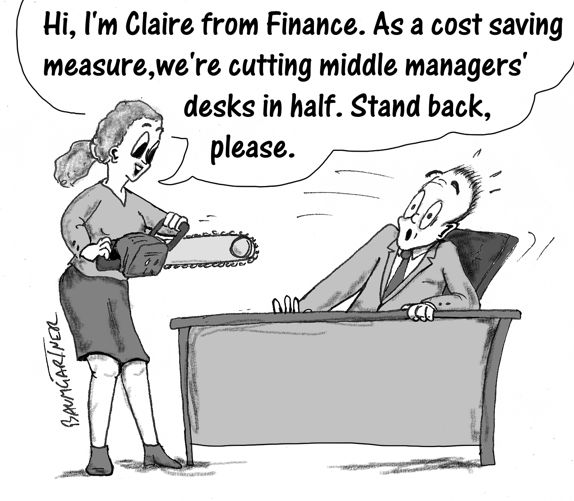
Efficiency Innovation: How to Find Cost Cutting Ideas
By Jeffrey Baumgartner
A version of this article was originally published in Report 103 in 2008 when the global economy had been hit by the US bank meltdown. With Brexit and, worse, a possible Trump presidency in the US, the global economy is again looking fragile. So, I believe it is worth reading again. It has been slightly revised since its first publication.
Business innovation is not just exciting new products and business models. It can also applied to every financial manager's favourite activity: cost cutting.
There are good ways and bad ways to cut costs in your business. The bad ways reduce costs in the short term, but lead to unhappy, demotivated employees in the longer term. This, in turn, leads to reduced productivity and engagement which results in reduced income. In other words, bad cost cutting tends to result in income cutting as well. The good ways to cut costs lead to employee engagement, active participation in cost cutting initiatives and more happiness.
Employee Satisfaction
Maximising employee satisfaction during cost cutting initiatives is critical. There few things people in medium to large companies like less than being given a set of new rules designed to cut costs. Employees hate being told they will have to trade in their company cars for a smaller models (or worse, bus passes), that they can no longer fly business class or that their photocopier use is being monitored to ensure it is only being used exclusively for company business. To you as management, the savings across the enterprise from such activities is substantial. To employees it is being petty and “another example of how little the company cares about me.”
On the other hand, if employees propose cost cutting suggestions themselves and feel they are a part of the cost cutting decision making process, they are not only more likely to be willing to co-operate, but they may well be enthusiastic about participation. After all, if an employee's cost saving idea is implemented, she has a stake in its success. If the idea succeeds, she can take part of the credit for its success.
Moreover, when employees in a medium to large firm start generating and collaborating on cost saving ideas, they are more likely to look at the big economic picture.
An employee told that she cannot use the office printers for personal reasons is likely to think: “I don't understand why I can't print these recipes I found on the web. It only costs the company a few cents.” But, if she is asked to find ways to cut costs across the company, the issue is no longer personal. It is an enterprise issue and that encourages enterprise calculations: “Hey, I've just noticed that the company spends $2 million a year on paper. If we could reduce that by 20% it would equal a cost savings of $400,000 a year!
Hands-On Knowledge
The larger a company becomes, the further removed top management are from its physical day to day operations. The CFO might receive a report that indicates electricity costs have increased 12% since last year. A junior accountant, on the other hand, is more likely to notice that 3/4 of her colleagues leave their computers on when they leave the office at the end of the day. Driving by the office at night, she might also notice that the building is lit up like a Christmas tree even when no one is working.
As a result, if the CFO is looking for ways to cut electricity costs, she is likely to look at broad solutions and possibly negotiating with the electricity supplier. The junior accountant is likely to suggest requiring people to turn off computers and lights when they leave the office at the end of the day. The combination of ideas is likely to lead to more substantial cost savings than either individual's ideas alone. But the accountant's ideas have the advantage of being easier and faster to implement.
Employees are the ones performing the operations of the company. They see inefficiencies in the details that management does not notice. By combining the hands-on knowledge and experience of employees with the big picture knowledge of top management, you are likely to develop the most comprehensive cost savings ideas.
How to Generate Cost Cutting Ideas
Unlike many forms of innovation, devising cost cutting ideas is well suited to suggestion scheme and idea management software because the aim is usually to generate a large number of viable, easy to implement ideas. So, if you are using an idea management software, try posing some of these challenges:
“In what ways might we reduce our use of electricity?”
“How might we cut down on the amount of paper we use?”
"What absurd practices do we do that we do not need to do?"
"What could you do to reduce wastage?"
And so on...
Doubtless, you can devise numerous more such challenges based on your operations and areas where you need to cut costs.
What the Experts Say
I decided to pose the question of “How do you challenge employees in an organisation to come up with cost cutting ideas?” to the International discussion forum (which has been closed down since this article's original publication) of the Imagination Club (www.imaginationclub.org) which includes innovation consultants, academics, students, scientists and others from all walks of life (and you can join us too!). There were several good responses.
Andrew Greaves of The Idea Hunter (www.theideahunter.co.uk) suggested some more thought-provoking challenges:
“In what ways might we make our interactions with other departments more effective/efficient?”
“How might we avoid certain processes being repeated by others?”
“What things could we re-use that we currently don't?”“Where might subsidies (govt. or otherwise) be available? Who could co-fund any of our activities?”
These are terrific. I have never yet come across a medium to large organisation that did not have substantial room for improvement in terms of inter-departmental interactions and repetition of processes. In the worst case scenarios, I've known organisations that send different sales people to the same prospective client, each delivering a different message. The result is that the client is confused and less than impressed while the employer of the sales people has wasted substantial money sending two people to confuse a message that one person could have delivered coherently.
Looking for subsidies is perhaps a particularly European approach to income generation. Not only do national governments offer all kinds of grants and subsidies. But the European Union is also generous in this respect.
Other Approaches
If your ideation is being done by small groups, it is possible to be even more creative than simply posing challenges.
Itha Taljaard of Sense2Solve (www.sense2solve.com) suggests taking a more hands-on, experienced based approach to generating cost cutting ideas. She says:
“I had a team once who wanted to reduce the use of paper (don't we all?). Instead of just coming up with ideas, I suggested they select a day as a paperless day and on that day have very specific ways to measure how much paper is used and which team used the least. It was a fun way to discover very practical ways to save paper.
“Initial ideas are often too vague or high level to be of any value. Forcing people to "live" it, switches on their minds.
“In South Africa the energy crisis certainly is making people think about how to reduce energy dependence. The suggestion to switch the electricity off for a day/few hours could get people to think creatively about electricity – provided they know it is an intentional black-out. Normally when electricity goes off here in South Africa, people go home if it happens in the afternoon, or they sit around and talk, waiting for the electricity to come back on again. Instead they could be turning that "dead" time into brainstorming time.”
Creativity consultant and researcher Randah Taher suggests going even further and becoming – in your mind – part of the issue. She sites from the work of Michael Michalko:
“The managers at a utility company wanted to dramatically reduce capital equipment costs. They spent three months imagining themselves as a kilowatt traveling through the company's various fossil fuel and nuclear power systems. As they imagined themselves traveling through each stage, they began to understand the complexity and diversity of the systems and saw ways to improve them. Their imaginary travels led to a redesigned maintenance plan that reduced the cost of maintenance ten times by replacing key parts instead of whole system." - Michael Michalko "Cracking Creativity" p. 46
Benefit: Fast Return on Investment (RoI)
One the best things about getting employees involved in cost cutting innovation is that you very quickly see a return on investment. Moreover, that return on investment is often easily measurable..
For many senior managers who are uncomfortable with the foggy RoI (return on investment) often associated with innovation, clear dollars and cents returns helps innovation make sense!
And It's Good for the Environment
If I haven't sold you on the advantages of cost cutting innovation yet, consider this: most cost cutting results in reduced usage of natural resources. Using less electricity is good for slowing down global warming. Using less packaging means less wastage when customers open up your products. Improving production line efficiency usually means reduced energy costs. All of these things not only save your company money – but they help our environment too!
Recent Articles
Leading Diverse Teams
Filed under: Business Innovation
Diverse teams are more innovative and smarter than homogeneous ones. But, they are also harder to manager. Here are some tips. By Jeffrey Baumgartner -- Read the article...
Questions you should ask when an innovative project fails
Filed under: Business Innovation
You can learn a lot from the failure of an innovative project, but you need to ask the right questions. Here are those questions. By Jeffrey Baumgartner -- Read the article...
Unmarketing the Competition
Filed under: Business Innovation
A look at creative, but unethical dirty trick marketing campaigns designed to damage the competition By Jeffrey Baumgartner -- Read the article...
Imaginativefulness and the Fisherman
Filed under: Creativity
What does a fisherman wearing a cycling helmet have to do with imaginativefulness? Quite a lot, it seems. By Jeffrey Baumgartner -- Read the article...
Actually, Criticising Ideas Is Good for Creativity
Filed under: Creativity
People have long assumed criticising ideas in a brainstorm inhibits creativity. Research and experience shows that is wrong By Jeffrey Baumgartner -- Read the article...
Imaginativefulness
Filed under: Creativity
Imaginativefulness is a state of heightened imagination in which your mind allows thoughts, memories and ideas to play with each other freely. By Jeffrey Baumgartner -- Read the article...
Why and How to Exploit Alternative Uses for Your Products
Filed under: Business Innovation
Discovering new ways customers use, misuse and could use your products can inspire innovation. Jeffrey Baumgartner explains. By Jeffrey Baumgartner -- Read the article...
The Cost of Not Innovating
Filed under: Business Innovation
If your company fails to innovate, you pay a steep price in terms of loss of leadershop, tight margins, missed opportunities and more. By Jeffrey Baumgartner -- Read the article...
Don't Trust the Status Quo
Filed under: Creativity
Jeffrey Baumgartner has never trusted the status quo. He explains why this is so and why you should also not trust the status quo By Jeffrey Baumgartner -- Read the article...
Index of all creative articles...




